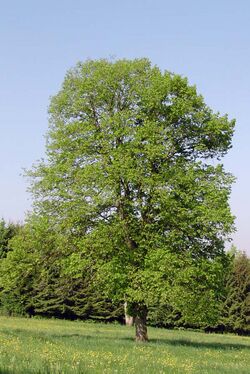Biology:Tiliaceae

Tiliaceae (/ˌtɪliˈeɪsii/) is a family of flowering plants. It is not a part of the APG, APG II and APG III classifications, being sunk in Malvaceae mostly as the subfamilies Tilioideae, Brownlowioideae and Grewioideae, but has an extensive historical record of use.
All through its existence the family has had a very lively history, with various authors taking very different views on what should be part of this family. As a result, it is recommended when this name is encountered to check what the author means.
However, in the northern temperate regions the name is unambiguous as the only representative is Tilia, the lime or linden.
APG II system
The APG II system, does not recognise this as a family but submerges it in the Malvaceae sensu lato, which unites the four families Bombacaceae, Malvaceae sensu stricto, Sterculiaceae and Tiliaceae. Modern botanical taxonomy, such as the relevant volume in the Kubitzki series which conforms to APG, treats most of the plants that traditionally constitute the family (see above) in the subfamilies Tilioideae, Brownlowioideae, and Grewioideae within this extended family Malvaceae sensu lato. Cladistically, the traditional family Tiliaceae is polyphyletic.
de Candolle system
In the de Candolle system the circumscription of the family was:
- family Tiliaceae
- genus I. Sparmannia [sic: now Sparrmannia]
- genus II. Abatia
- genus III. Heliocarpus
- genus IV. Antichorus
- genus V. Corchorus
- genus VI. Honckenya [sic, see Clappertonia]
- genus VII. Triumfetta
- genus VIII. Grewia
- genus IX. Columbia [sic, now Colona]
- genus X. Tilia
- genus XI. Diplophractum
- genus XII. Muntingia
- genus XIII. Apeiba
- genus XIV. Sloanea
- genus XV. Ablania
- genus XIV. Gyrostemon
- genus XVII. Christiana
- genus XVIII. Alegria
- genus XIX. Luhea [sic, now: Luehea]
- genus XX. Vatica
- genus XXI. Espera
- genus XXII. Wikstroemia
- genus XXIII. Berrya
According to APG II system, the current placement of these genera is mostly in the Malvaceae sensu lato, but with Gyrostemon moved to family Gyrostemonaceae, Muntingia to family Muntingiaceae, Sloanea to family Elaeocarpaceae, Vatica to family Dipterocarpaceae and Wikstroemia to family Thymelaeaceae (possibly reduced to a synonym of Daphne). The genus Abatia is assigned to the family Salicaceae sensu lato.
Bentham & Hooker system
The family reached perhaps its widest circumscription in the Bentham & Hooker system:
- family XXXIII Tiliaceae
- series A. Holopetalae
- tribus I. Brownlowieae
- genus 1. Brownlowia
- genus 2. Pentace
- genus 3. Diplodiscus
- genus 4. Pityranthe
- genus 5. Christiana
- genus 6. Berrya
- genus 7. Carpodiptera
- tribus II. Grewieae
- genus 8. Grewia
- genus 9. Columbia [sic, now Colona]
- genus 10. Diplophractum
- genus 11. Belotia
- genus 12. Erinocarpus
- genus 13. Triumfetta
- genus 14. Heliocarpus
- tribus III. Tilieae
- genus 15. Entelea
- genus 16. Sparrmannia
- genus 17. Honckenya [sic, see Clappertonia]
- genus 18. Corchorus
- genus 19. Corchoropsis
- genus 20. Luehea
- genus 21. Mollia
- genus 22. Trichospermum
- genus 23. Muntingia
- genus 24. Tilia
- genus 25. Leptonychia
- genus 26. Schoutenia
- tribus IV. Apeibeae
- genus 27. Glypilea
- genus 28. Apeiba
- tribus I. Brownlowieae
- series B. Heteropetalae
- tribus V. Prockieae
- genus 29. Prockia
- genus 30. Hasseltia
- genus 31. Plagiopteron
- genus 32? Ropalocarpus
- tribus VI. Sloanieae
- tribus VII. Elaeocarpeae
- genus 37. Aristotelia
- genus 38. Elaeocarpus
- genus 39. Dubouzetia
- genus 40. Tricuspidaria
- tribus V. Prockieae
- series A. Holopetalae
According to APG II system, the current placement of these genera is perhaps mostly in the Malvaceae sensu lato, but with Muntingia moved to family Muntingiaceae, while tribes VI and VII form the core of family Elaeocarpaceae and tribe V has been moved to the family Salicaceae sensu lato.
The Hutchinson system follows the Bentham & Hooker system rather closely.
Cronquist system
In the Cronquist system (1981) the family includes some fifty genera, totalling around seven hundred species of trees and shrubs, rarely herbs, with a subcosmopolitan distribution. It may be separated from Malvaceae sensu stricto by the smooth surface of the pollen grains, bilocular anthers, and the stamens free or in bundles (but not monadelphous)
- Ancistrocarpus Oliv.
- Apeiba Aubl.
- Asterophorum Sprague
- Berrya Roxb.
- Brownlowia Roxb.
- Burretiodendron Rehder
- Carpodiptera Griseb.
- Christiana DC.
- Clappertonia Meisn.
- Colona Cav.
- Corchoropsis Siebold & Zucc.
- Corchorus L.
- Craigia W.W.Sm. & W.E.Evans
- Desplatsia Bocq.
- Dicraspidia Standl.
- Diplodiscus Turcz.
- Duboscia Bocquet
- Eleutherostylis Burret
- Entelea R.Br.
- Erinocarpus Nimmo ex J.Graham
- Glyphaea Hook.f.
- Goethalsia Pittier
- Grewia L.
- Hainania Merr.
- Heliocarpus L.
- Hydrogaster Kuhlm.
- Jarandersonia Kosterm.
- Luehea Willd.
- Lueheopsis Burret
- Microcos L.
- Mollia Mart.
- Mortoniodendron Standl. & Steyerm.
- Neotessmannia Burret
- Pentace Hassk.
- Pentaplaris L.O.Williams & Standl.
- Petenaea Lundell
- Pityranthe Thwaites
- Pseudocorchorus Capuron
- Schoutenia Korth.
- Sicrea (Pierre) Hallier f.
- Sparrmannia L.f.
- Tetralix Griseb.
- Tilia L.
- Trichospermum Blume
- Triumfetta L.
- Vasivaea Baill.
- Westphalina A.Robyns & Bamps
External links
- Tiliaceae in L. Watson and M.J. Dallwitz (1992 onwards) The families of flowering plants: descriptions.
Wikidata ☰ Q1929656 entry
 |
